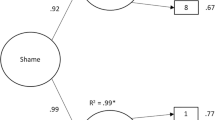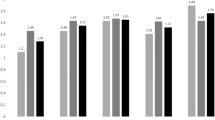Abstract
Research on the emotion of shame has increased significantly in recent years. However, there remains a need for more psychometrically sound measures of shame, including measures of shame in response to specific, idiographic experiences. The Shame Inventory was developed in order to assess both global feelings of shame as well as shame in response to specific life events or personal characteristics. Two studies were conducted to determine the preliminary psychometric properties of the Shame Inventory. Across both studies, results indicate that the inventory has high internal consistency, test-retest reliability, construct validity, and predictive validity. The Shame Inventory holds promise as a new measure designed to assess both global feelings of shame as well as specific shame-eliciting cues.
Similar content being viewed by others
References
Allan, S., Gilbert, P., & Gross, K. (1994). An exploration of shame measures-II: psychopathology. Personality and Individual Differences, 17, 719–722.
Andrews, B., Brewin, C. R., Rose, S., & Kirk, M. (2000). Predicting PTSD symptoms in victims of violent crime: the role of shame, anger, and childhood abuse. Journal of Abnormal Psychology, 109, 69–73.
Andrews, B., Qian, M., & Valentine, J. D. (2002). Predicting depressive symptoms with a new measure of shame: the experience of shame scale. British Journal of Clinical Psychology, 41, 29–42.
Averill, P. M., Diefenbach, G. J., Stanley, M. A., Breckenridge, J. K., & Lusby, B. (2002). Assessment of shame and guilt in a psychiatric sample: a comparison of two measures. Personality and Individual Differences, 32, 1365–1376.
Brown, M. Z., Comtois, K. A., & Linehan, M. M. (2002). Reasons for suicide attempts and nonsuicidal self-injury in women with borderline personality disorder. Journal of Abnormal Psychology, 111, 198–202.
Cook, D. R. (1996). Empirical studies of shame and guilt: The Internalized Shame Scale. In D. L. Nathanson (Ed.), Knowing feeling: affect, script, and psychotherapy. New York: Norton.
Covert, M. V., Tangney, J. P., Maddux, J. E., & Heleno, N. M. (2003). Shame-proneness, guilt-proneness, and interpersonal problem solving: a social cognitive analysis. Journal of Social and Clinical Psychology, 22, 1–12.
Feiring, C., Taska, L., & Lewis, M. (2002). Adjustment following sexual abuse discovery: the role of shame and attributional style. Developmental Psychology, 38, 79–92.
Foster, A, & Rizvi, S.L. (2008). What are we measuring with shame and guilt measures? Problems of definitional obfuscation. Poster presented at the annual meeting of the association for behavioral and cognitive therapies, Orlando, FL.
Goss, K., Gilbert, P., & Allan, S. (1994). An exploration of shame measure-I: the other as shamer scale. Personality and Individual Differences, 17, 713–717.
Harder, D. W., Cutler, L., & Rockart, L. (1992). Assessment of shame and guilt and their relation to psychopathology. Journal of Personality Assessment, 59, 594–604.
Harder, D. W. & Lewis, S. J. (1987). The assessment of shame and guilt. In J. N. Butcher & C. D. Spielberger (Eds.), Advances in personality assessment (pp. 89–114). Hillsdale: Erlbaum.
Harder, D. W., Rockart, L., & Cutler, L. (1993). Additional validity evidence for the harder personal feelings questionnaire-2 (PFQ-2): a measure of shame and guilt proneness. Journal of Clinical Psychology, 49, 345–348.
Harder, D. H. & Zalma, A. (1990). Two promising shame and guilt scales: a construct validity comparison. Journal of Personality Assessment, 55, 729–745.
Harper, F. W. K. & Arias, I. (2004). The role of shame in predicting adult anger and depressive symptoms among victims of child psychological maltreatment. Journal of Family Violence, 19, 367–375.
Hastings, M. E., Northman, L. M., & Tangney, J. P. (2000). Shame, guilt, and suicide. In T. Joiner & M. D. Rudd (Eds.), Suicide science: expanding the boundaries (pp. 67–79). Boston: Kluwer Academic.
Hoblitzelle, W. (1987). Differentiating and measuring shame and guilt: The relation between shame and depression. In H. B. Lewis (Ed.), The role of shame in symptom formation (pp. 207–235). Hillsdale: Lawrence Erlbaum.
Izard, C. E. (1977). Human emotions. New York: Plenum.
Keltner, D. & Buswell, B. N. (1996). Evidence for the distinctness of embarrassment, shame, and guilt: a study of recalled antecedents and facial expressions of emotion. Cognition and Emotion, 10, 155–171.
Kleindienst, N., Bohus, M., Ludascher, P., et al. (2008). Motives for nonsuicidal self-injury among women with borderline personality disorder. Journal of Nervous and Mental Disease, 196, 230–236.
Kroll, J. & Egan, E. (2004). Psychiatry, moral worry, and the moral emotions. Journal of Psychiatric Practice, 10, 352–360.
Kubany, E. S., Abueg, F. R., Kilanuano, W. L., Manke, F. P., & Kaplan, A. S. (1997). Development and validation of the sources of trauma-related guilt survey: war-zone version. Journal of Traumatic Stress, 10, 235–258.
Kubany, E. S., Haynes, S. N., Abueg, F. R., Manke, F. P., Brennan, J. M., & Stahura, C. (1996). Development and validation of the trauma-related guilt inventory (TRGI). Psychological Assessment, 8, 428–444.
Lester, D. (1998). The association of shame and guilt with suicidality. The Journal of Social Psychology, 138, 535–536.
Lewis, H. B. (1971). Shame and guilt in neurosis. New York: International Universities.
Lewis, M. (2000). Self-conscious emotions: embarrassment, pride, shame, and guilt. In M. Lewis & J. M. Haviland-Jones (Eds.), Handbook of emotions (2nd ed., pp. 623–636). New York: Guilford.
Mackinnon, A., Jorm, A. F., Christensen, H., Korten, A. E., Jacomb, P. A., & Rodgers, B. (1999). A short form of the positive and negative affect schedule: evaluation of factorial validity and invariance across demographic variables in a community sample. Personality and Individual Differences, 27, 405–416.
Marschall, D. E., Sanftner, J., & Tangney, J. P. (1994). The state shame and guilt scale. George Mason University.
Rizvi, S. L. & Linehan, M. M. (2005). The treatment of maladaptive shame in borderline personality disorder: a pilot study of "Opposite Action". Cognitive and Behavioral Practice, 12, 437–447.
Rusch, N., Lieb, K., Gottler, I., et al. (2007). Shame and implicit self-concept in women with borderline personality disorder. American Journal of Psychiatry, 164, 500–508.
Tangney, J. P. & Dearing, R. L. (2002). Shame and guilt. New York: Guilford.
Tangney, J. P., Dearing, R. L., Wagner, P. E., & Gramzow, R. (2000). The test of self-conscious affect-3 (TOSCA-3). George Mason University.
Tangney, J. P., Wagner, P. E., & Gramzow, R. (1989). The test of self-conscious affect (TOSCA). Fairfax: George Mason University.
Tangney, J. P., Wagner, P., & Gramzow, R. (1992). Proneness to sahme, proneness to guilt, and psychopathology. Journal of Abnormal Psychology, 101, 469–478.
Tracy, J. L. & Robins, R. W. (2004). Putting the self into self-conscious emotions: a theoretical model. Psychological Inquiry, 15, 103–125.
Tracy, J. L. & Robins, R. W. (2006). Appraisal antecedents of shame and guilt: support for a theoretical model. Personality and Social Psychology Bulletin, 32, 1339–1351.
Turner, J. E. (1998). An investigation of shame reactions, motivation, and achievement in a difficult college course. Unpublished doctoral dissertation, University of Texas, Austin.
Watson, D. & Clark, L. A. (1997). Measurement and mismeasurement of mood: recurrent and emergent issues. Journal of Personality Assessment, 68, 267–296.
Watson, D., Clark, L. A., & Tellegen, A. (1988). Development and validation of brief measures of positive and negative affect: the PANAS scales. Journal of Personality and Social Psychology, 54, 1063–1070.
Acknowledgement
The author would like to thank Michael Suvak, Brett Litz, Tracie Shea, and Shirley Yen for assistance with data collection and comments on earlier versions of the measure, Marsha Linehan for assistance with measure development, and Kristalyn Salters-Pedneault and Sarah Reynolds for comments on versions of this manuscript.
Author information
Authors and Affiliations
Corresponding author
Appendix. The Shame Inventory
Appendix. The Shame Inventory
Part I
Shame is a negative and painful feeling in which the entire self is viewed as bad and/or worthless. It may be accompanied by urges to withdraw or conceal some behavior or aspect of yourself. Shame is different from just generally being upset or distressed, because it relates to how you feel about yourself. Some people experience shame on a regular basis; others hardly experience shame at all.

Part II
This is a list of situations and behaviors that may be related to the experience of shame for you. Please write a number (between 0–4) beside each statement which indicates the intensity of your shame about that event. If the statement does not apply to you, write an “X” beside the statement.


Rights and permissions
About this article
Cite this article
Rizvi, S.L. Development and Preliminary Validation of a New Measure to Assess Shame: The Shame Inventory. J Psychopathol Behav Assess 32, 438–447 (2010). https://doi.org/10.1007/s10862-009-9172-y
Published:
Issue Date:
DOI: https://doi.org/10.1007/s10862-009-9172-y




